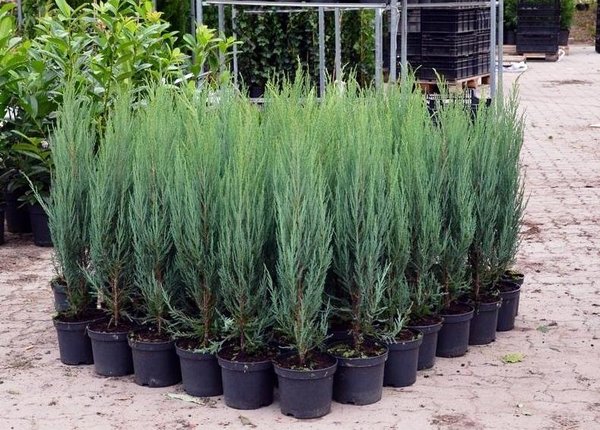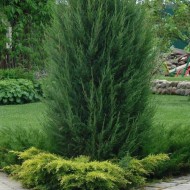Acquaintance with the Skyrocket juniper: decorative properties and agricultural technology
Content
Breeding history
Juniperus scopulorum, or rocky juniper, is one of the brightest representatives of Cypress. These evergreens are considered an indispensable element for decorating a garden, park, and adjoining territories. In total, there are about 20 varieties of rocky juniper, one of which is Skyrocket. Skyrocket literally translates as "sky rocket". It is not surprising, because the shape of the plant really resembles a rocket that rushes into the sky.

This variety was bred in 1980. The variety was brought from North America and perfectly adapted to the climatic conditions of Russia.
Video "Planting and caring for a juniper"
In this video, an expert will tell you how to properly plant a juniper and care for a plant.
Decorative properties of Skyrocket juniper
A variety of Virginia juniper is characterized by a columnar shape. The branches of the culture grow from the very base and have a bluish-gray tint. At first glance, it may seem that rocky juniper is categorically unsuitable for regions with severe winters and strong winds. However, in fact, he firmly tolerates any adverse environmental conditions. The juniper is very firmly held, because the roots of the plant go deep underground. Therefore, even the strongest wind does not pose a particular danger to this culture.
It should be borne in mind that high levels of decorativeness of juniper directly depend on the frequency of pruning. The plant grows up to 8 m. Annual growth is 15-20 cm in height and about 4-6 in width.
Pros and cons of the variety
The main advantages of Skyrocket juniper are:
- high indicators of vitality;
- unpretentious care;
- the ability to adapt even to adverse environmental conditions;
- no need for frequent crown formation;
- frost resistance;
- immunity to many fungal diseases and pests.
However, there are some disadvantages of Skyrocket:
- the importance of formative pruning;
- susceptibility to disease in case of non-compliance with the standards of care.
Features of planting and care
As experienced gardeners say, the younger a plant is planted, the more likely it is that it will take root quickly. What else influences the successful cultivation of rocky juniper in the garden?

Site and soil selection
Despite the unpretentiousness of the juniper, the most suitable soil option for it would be a loamy soil with a low level of acidity. An open sunny area protected from drafts is considered an ideal planting site.
Selection and preparation of seedlings
For planting, seedlings with a height of 1 meter are chosen. As practice shows, they adapt and take root in a new place the fastest.If the juniper is more than 1.5 years old, it must be planted with a clod of earth. This will make the transplanting process less stressful for the plant. You should buy planting material only from trusted suppliers or specialized stores. Otherwise, there is a great risk of acquiring low-quality seedlings. Before planting, seedlings should be inspected for damage, rot and mold.
Planting process
The dimensions of the pit should be 2 times the dimensions of the earthen coma. If you are planting a seedling, the depth of the hole should be 1 meter, and the width should be 80 cm. It is important to put a drainage layer on the bottom of the groove, which will prevent stagnation of moisture in the soil. Next, you need to add a layer of top dressing: compost or manure.
Fertilizing the soil at the time of planting greatly affects the further growth rate of the juniper.
The root collar should be 10 cm above the ground. After burying the roots, the soil must be tamped and watered abundantly. After a couple of days, it will be necessary to add soil to the zone of the trunk circle, because over time it will sag.
Care activities
In the summer, watering is carried out twice a week. Moreover, it is important to correctly calculate the required amount of water: for every meter of juniper height, 10 liters of liquid are required. With the onset of autumn, watering is carried out once a week, as in spring. Given that juniper does not tolerate moisture deficit in the soil, it is important to loosen the soil regularly. In order not to do this procedure too often, you can resort to the mulching method. All kinds of organic materials such as sawdust perfectly retain moisture in the trunk circle.
In addition, it is important to abundantly spray the plant with growth stimulants. Fertilizing the culture is necessary exclusively with special preparations for needles. Organic fertilizing in the case of conifers is categorically inappropriate - they can lead to disease and death of the plant.

The rocky juniper needs pruning, which must be done once a year. The need for this procedure is due to the peculiarity of the plant - the shoots, growing up to 30 cm, begin to separate from the trunk, negatively affecting the general appearance of the bush. Thus, regular pruning keeps the plant looking neat.
If you rely on the description of the coniferous culture, we can conclude about the frost resistance of the plant. However, in regions with harsh winters, gardeners still need to warm their evergreen pets.
Preparation for winter should be carried out with the onset of autumn cold weather. Juniper trunks are wrapped with a special non-woven fiber and secured with a rope. To protect the root system from excessively low temperatures, it is necessary to mulch the trunk circle with a thick layer of organic material.
Pest and disease control
The most common pests that can be found in the branches of coniferous crops are:
- caterpillars;
- mole;
- shield;
- spider mite.
To prevent infestation by these insects, experienced gardeners recommend resorting to insecticidal preparations. To protect the tree from rust, the most dangerous disease for conifers, you need to treat the culture with preparations that contain copper.
Juniper Skyrocket in the landscape
Juniper Skyrocket is very often used in garden design. Often, with the help of a plant, hedges are created, various shapes are made. Best of all, rocky juniper is combined with cereals and roses. Also, coniferous culture is in harmony with deciduous and coniferous trees. Such compositions will perfectly decorate any garden.
- Often, hedges are created with the help of a plant.
- The plant has high decorative qualities.
- Juniper Skyrocket is very often used in garden design.
Reviews of Skyrocket Juniper
The unpretentiousness and high decorative performance of the Skyrocket rocky juniper is indicated by the reviews of those who planted the culture in their summer cottage.
“We have a rather large suburban area, so we wanted to do something unusual in terms of design. They didn’t think of anything better how to plant a juniper composition. It turned out not in vain. The garden now looks somehow festive, in a special way. It would seem that such a common plant, but how it decorates the site! "
“The Juniper Skyrocket is my love. I have not yet met such an unpretentious plant. But what beauty he creates in the garden. In order for the plant to please the eye and not hurt, you just need to familiarize yourself with the rules for growing juniper and follow them. No special knowledge is required anymore. "
Rock juniper is not in vain so fond of domestic summer residents. This plant is able to decorate any area, while not requiring a special approach to itself.



